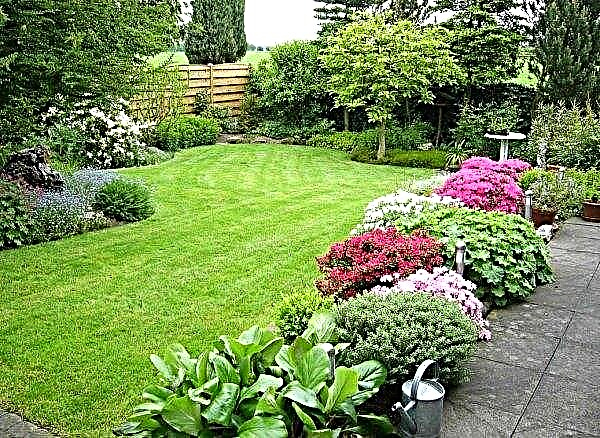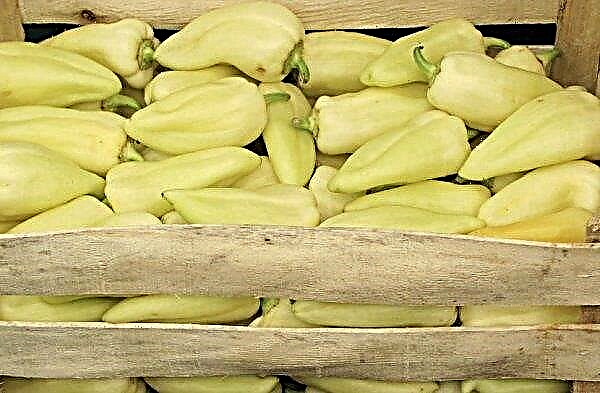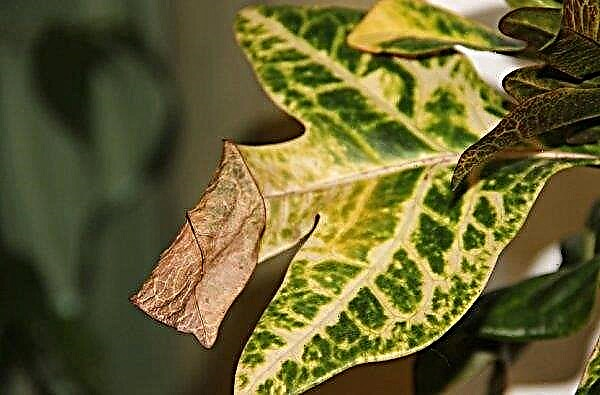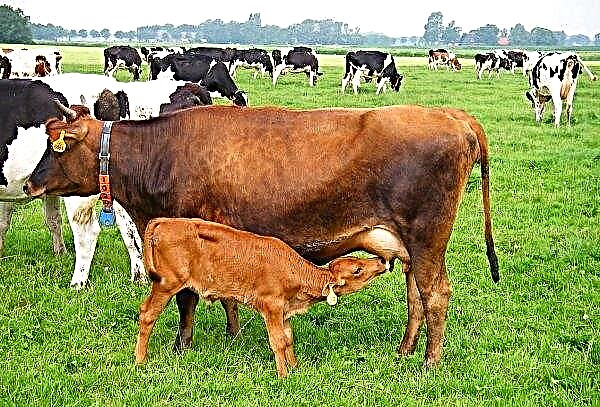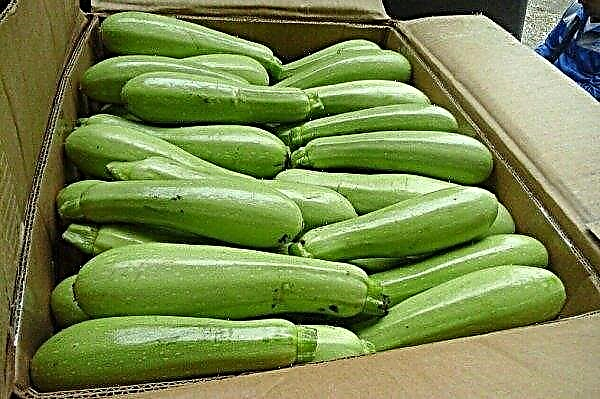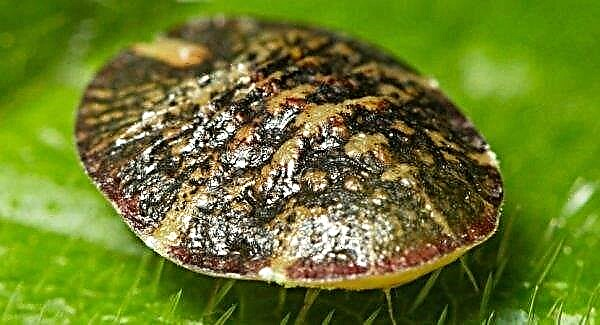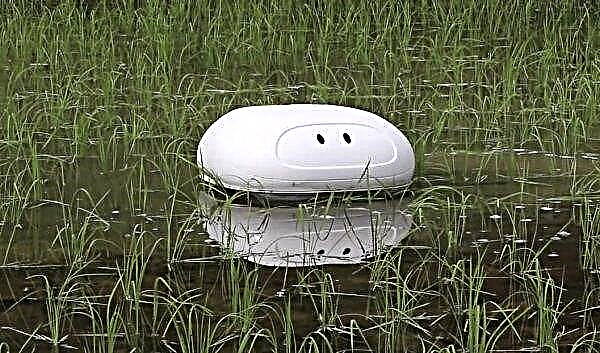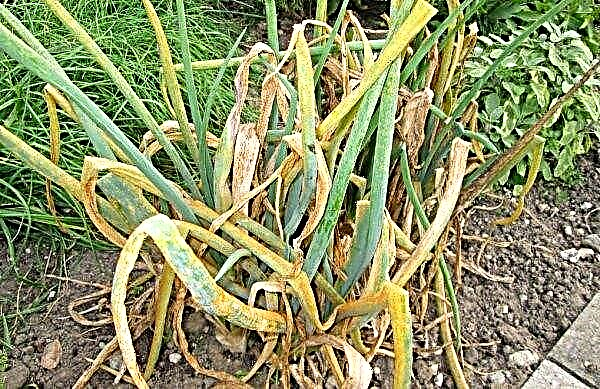Massive yellowing and drying out of branches, gnawed bark, lifeless and twisted young shoots - such tracks on pines leave black caterpillars. The trees on which they live, lose their decorativeness, poorly developed and die after 3-4 years.
Therefore, timely prevention is important for coniferous planting, and in case of detection of the first signs of pest activity, intensive treatment. The main methods of controlling parasitic insects will be discussed later.
Danger to the tree
Small cocoons and distinctive depressions at the base of the needles testify to the appearance of caterpillars on coniferous crops. At first, with a slight lesion, it is difficult to notice the pest, since its adhesive web holds needles. The splendor of the branches disappears with strong gusts of wind, when lifeless studs crumble.
Did you know? The body of the caterpillar consists of 4 thousand muscles, when there are only 629 of them in the human body.
Obvious signs of the appearance of the pest are expressed in proportion to its reproduction. Then, on the trees, large yellowed and dry zones are visible, which crumble when touched. Young thorns are characterized by unnatural pallor and lifelessness. Old ones are twisted.
 From attacks of caterpillars pine more suffer up to 30 years of age. Parasites prefer to eat juicy growth of the last year. But, settling on a tree, due to lack of food, they eat up all the needles and even bark.
From attacks of caterpillars pine more suffer up to 30 years of age. Parasites prefer to eat juicy growth of the last year. But, settling on a tree, due to lack of food, they eat up all the needles and even bark.
As a result, the plant weakens, ceases to develop and gradually withers. If nothing is done, it will lose its appeal and die in a few years. In the event of a repeated seasonal attack, the damaged pine will not be able to winter.
According to experts, the spread of harmful insects is promoted by insufficiently maintained forests and the absence of preventive measures in private households. It is noticed that more often decorative species of conifers suffer from parasitic living creatures. For example, Weimutov pine, Banks and others.
Did you know? Among the long-lived caterpillars, the most resilient is considered to be the most durable in Canada and Greenland Gynaephora groenlandica. She lives up to 14 years and can winter at -70 ° C.
Types of Caterpillars
Many people think that conifers due to the specific pungent odor, high resin composition and prickly structure of evergreen foliage are unattractive to insects. However, in fact, pines, spruce, cypress and thuja are often attacked by pests, the larvae of which cause serious damage to them. It is characteristic that during the season the parasites twice breed offspring.
Gnawing needles of a caterpillar as a measure of its development usually turn into:
- Ginger sawflies ("false caterpillars"). Widely distributed throughout the Eurasian continent, as well as partially in North America. Adults are characterized by an elongated shiny body of black or yellow-brown color (depending on sexual dimorphism).
 Over the course of the season, their females lay at least hundreds of eggs that can hibernate even in frosts down to -40 ° C. In late August - early September, imagoes emerge from cocoons. Their main food is coniferous foliage and juices of young branches.
Over the course of the season, their females lay at least hundreds of eggs that can hibernate even in frosts down to -40 ° C. In late August - early September, imagoes emerge from cocoons. Their main food is coniferous foliage and juices of young branches.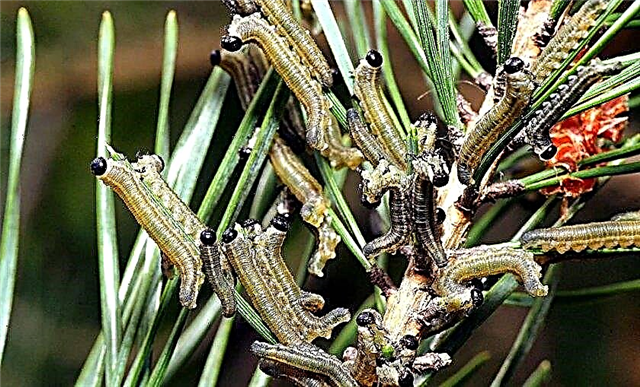
- Pine coconut, which are found throughout Europe, as well as in Siberia and are considered the most dangerous. Adult butterflies have gray-brown wings with three transverse stripes.
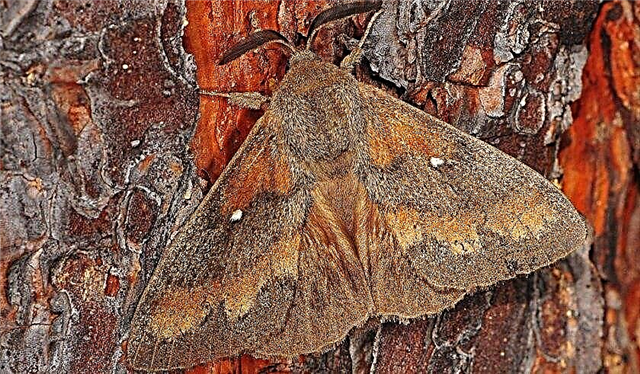 Their caterpillars appear in the middle of summer, are characterized by a strongly fleecy gray body up to 80 mm long. Depending on the abundance of feed and external factors, the color of the insect at all phases of the life cycle is variable. They feed exclusively on coniferous hairpins (each season each larva eats up to 1000 needles on average), and with the onset of cold weather they crawl into the round-trunk moss for wintering.
Their caterpillars appear in the middle of summer, are characterized by a strongly fleecy gray body up to 80 mm long. Depending on the abundance of feed and external factors, the color of the insect at all phases of the life cycle is variable. They feed exclusively on coniferous hairpins (each season each larva eats up to 1000 needles on average), and with the onset of cold weather they crawl into the round-trunk moss for wintering. 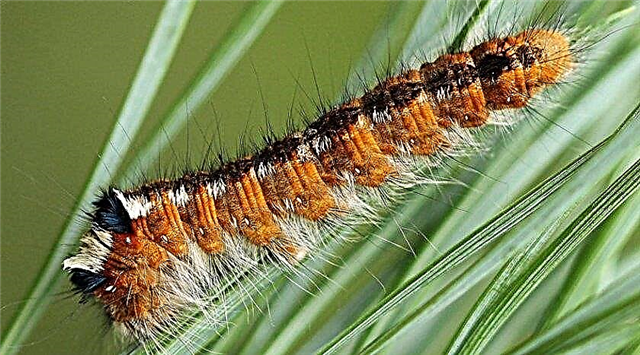 The transformation of the caterpillar into a chrysalis occurs only next summer. Then elongated gray cocoons appear in the pine branches. In a short period, these pests can completely destroy a hectare of coniferous planting.
The transformation of the caterpillar into a chrysalis occurs only next summer. Then elongated gray cocoons appear in the pine branches. In a short period, these pests can completely destroy a hectare of coniferous planting. - Pine moths. They are butterflies with black or red mottled wings (depending on sexual dimorphism), which lay eggs preferably in the old needles. Their caterpillars are characterized by a green body, up to 3 cm long, with 5 whitish longitudinal stripes. They appear in June and pupate in November. They feed on needles of different prescription and young buds. A characteristic feature of this pest is that its larvae slide into fallen foliage to form cocoons.
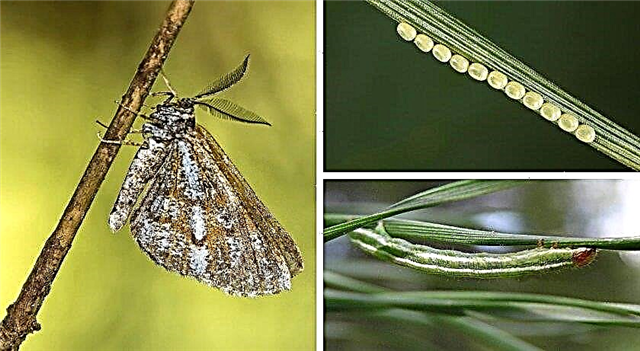
- Pine scoopwhose habitat is the entire northern hemisphere. The danger of these insects lies not only in the wide distribution, but also in the ability to spread other parasites. Adult butterflies are recognizable by the spotted fringe of their wings and gray-yellow belly. Their external color is variable, ranging from brown and gray-brown to orange and reddish colors. Caterpillars appear 2 weeks after egg laying, differ in a dark green body, up to 40 mm long, with a wide blurred white strip on the back. Their main food is pine needles, buds and young shoots. Their pupation occurs in mid-summer. For this phase of their development, the larvae crawl to the surface of the soil.
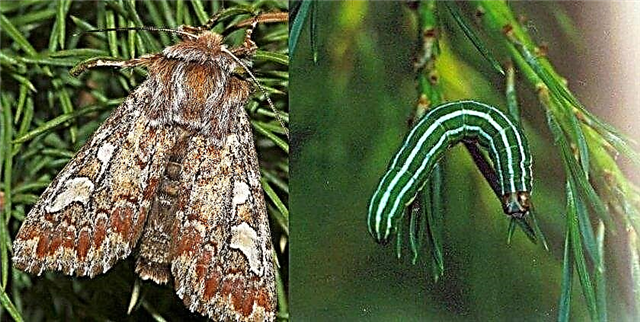
- Fire cone (spruce)that is widespread in Eurasia. Leads a hidden lifestyle. Adult individuals are characterized by a light gray color of the wings, on the upper pair of which zigzag transverse stripes and white dots are noticeable.
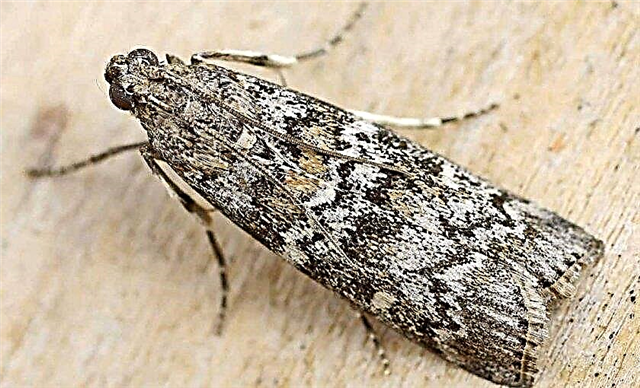 Caterpillars have a brownish-brown body, up to 27 mm long, with fuzzy longitudinal stripes of grayish and yellowish color. They spoil cones by eating their seeds and soft bases of scales, and also feed on vertex shoots. Often, larvae can be seen in areas of trees affected by fungal infections where tar has accumulated.
Caterpillars have a brownish-brown body, up to 27 mm long, with fuzzy longitudinal stripes of grayish and yellowish color. They spoil cones by eating their seeds and soft bases of scales, and also feed on vertex shoots. Often, larvae can be seen in areas of trees affected by fungal infections where tar has accumulated.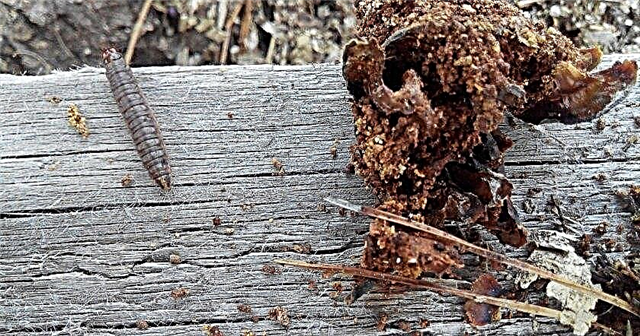 The unnatural brownish shade of damaged cones and red-brown accumulations of excrement on the tree testify to the vital activity of the fires.
The unnatural brownish shade of damaged cones and red-brown accumulations of excrement on the tree testify to the vital activity of the fires.
Important! Agrochemical methods of controlling pests of conifers, which lead a hidden lifestyle, are effective on the 3-4th day of the beginning of pollination of male inflorescences or in the period when young cones take a horizontal position.
Ways to fight
In well-groomed plantings of coniferous crops, attacking pests are a rarity. Favorable conditions for them create the wrong soil composition and acidity, as well as moisture conditions and the absence of preventive measures. A large number of parasites is usually observed in areas where soil hygiene is not observed and seedlings are affected by fungal, bacterial infections.

It is necessary to begin to fight harmful insects at the first signs of their vital activity. With a small number of pine needles, mechanical and biological methods are effective, and in cases of mass attacks only potent chemicals will help.
Manual collection
This option is more suitable for eliminating a small number of pine sawflies from young seedlings. It is important to remove not only larvae and adult butterflies from branches, but also laid eggs. Damaged kidneys and sprouts are also subject to removal. They, together with insects, are collected in a separate container and burned outside the planting area. The procedure is carried out in garden gloves and glasses.
In addition, the mechanical method involves the deep digging of the round bore circles. This is done to destroy the pupated individuals, which in the future can give new offspring. Some homeowners advise flushing caterpillars from decorative pines with a strong stream of water. After such manipulations, it is important to clean the area near the trunk.
Important! When manually collecting pine caterpillars, it is strictly forbidden to touch gloves to bare parts of the body, including the face. In response to danger, the larvae actively begin to spit up their own blood masses, which are high allergens.
On tall trees, the installation of a trapping belt is effective, the essence of which is to block the approaching pests. As a rule, this is a glue base of resin or tar, smeared on a fabric belt, which wraps the trunk.
 1 - clean the bark of the stem; 2 - tie the paper with twine; 3 - spread paper with glue.
1 - clean the bark of the stem; 2 - tie the paper with twine; 3 - spread paper with glue.
Alternatively, instead of the adhesive, the fabric can be treated with any insecticide. It should be borne in mind that such a trap is able to destroy caterpillars only in the phase of approaching pupation, when they will crawl, overcoming the blockage, to the ground.
Biological method
This method is based on the effects of herbal infusions and beneficial microorganisms.. The most common ingredients for the preparation of a solution from pine pests are garlic, tomato tops, tobacco, red chili peppers, liquid laundry soap.
Important! To increase the effectiveness of various methods and drugs, they must be used alternately, depending on the degree of damage and the condition of the trees.
The crushed raw materials are insisted (in a proportion of 300 g per 1 liter of water) for 24 hours at room temperature. After that, all the concentrate is bred in a bucket of water. The product is suitable for processing both young and mature conifers. However, its effectiveness is possible only with a small number of attacking parasites.

Also, experts in the fight against pine sawmills, scoops, moths and silkworms recommend the following biological products (working solution is prepared according to the manufacturers instructions):
- "Lepidobactoid";
- "Bitoxibacillin";
- "Lepidocide";
- Fitoverm.
Chemical treatment
Of the entire arsenal of protective equipment in the fight against coniferous caterpillars, chemical insecticides are considered the most effective. At the initial stages of infection, one spray is enough, and with mass occupation of the tree, up to 2-3 repetitions will be needed.
To eliminate the larvae, experts recommend the use of enteric-contact and systemic drugs that can eliminate insects, as well as their larvae and eggs.
Among them, they have proven themselves well:
- Arrivo
- "Creocide Pro";
- Inta-Vir;
- "Actellicus";
- "Aktara";
- "Fufanon";
- Novaktion;
- Vermitex.
Experienced foresters advise when buying protective products to buy insecticides of different actions, because pests are able to get used to the same poison.
 Spraying a pine planting is best done in the evening in calm, dry weather, observing the rules of self-protection when working with toxic substances.
Spraying a pine planting is best done in the evening in calm, dry weather, observing the rules of self-protection when working with toxic substances.
Prevention
In order to protect pines from parasitic insects, it is important to regularly inspect them.. This is especially true for trees that are at risk. Keep in mind that the activity of pests is activated on warm sunny days. In wet and rainy weather it is difficult to notice them on the needles.
Did you know? For pupation, the caterpillar weaves a cocoon from a string, the length of which reaches 1500 meters.
It is also important to annually, in the second half of autumn, to clean the fallen needles on the planting territory and dig the soil to the depth of a bayonet-shovel. These simple actions will contribute to the complete elimination of pupated individuals and hibernated larvae.
Heaps of collected pine hairpins cannot be left under the trees; they are carried outside the planting area and burned. Any flowers planted around the perimeter of the plot will distract the parasites onto themselves.
 Birdhouses hanging on adult trees will not be superfluous. Indeed, insects at different phases of their development are the main food for birds.
Birdhouses hanging on adult trees will not be superfluous. Indeed, insects at different phases of their development are the main food for birds.
In case of uninvited guests:
- Immediately remove damaged buds and branches from the pines.
- Wrap the barrel with sticky bait.
- Sprinkle all trees with any systemic insecticide.
Needles are no exception and, despite their biological characteristics, like leafy crops, attracts parasitic living creatures. The inactivity of man in this aspect is detrimental to plants. Therefore, it is important to initially take care of planting, observing elementary agrotechnical rules in the care of soil and vegetation on it. Preventive measures are also required. If you do everything correctly and on time, then saving the pines will not be necessary.

 Over the course of the season, their females lay at least hundreds of eggs that can hibernate even in frosts down to -40 ° C. In late August - early September, imagoes emerge from cocoons. Their main food is coniferous foliage and juices of young branches.
Over the course of the season, their females lay at least hundreds of eggs that can hibernate even in frosts down to -40 ° C. In late August - early September, imagoes emerge from cocoons. Their main food is coniferous foliage and juices of young branches.
 Their caterpillars appear in the middle of summer, are characterized by a strongly fleecy gray body up to 80 mm long. Depending on the abundance of feed and external factors, the color of the insect at all phases of the life cycle is variable. They feed exclusively on coniferous hairpins (each season each larva eats up to 1000 needles on average), and with the onset of cold weather they crawl into the round-trunk moss for wintering.
Their caterpillars appear in the middle of summer, are characterized by a strongly fleecy gray body up to 80 mm long. Depending on the abundance of feed and external factors, the color of the insect at all phases of the life cycle is variable. They feed exclusively on coniferous hairpins (each season each larva eats up to 1000 needles on average), and with the onset of cold weather they crawl into the round-trunk moss for wintering.  The transformation of the caterpillar into a chrysalis occurs only next summer. Then elongated gray cocoons appear in the pine branches. In a short period, these pests can completely destroy a hectare of coniferous planting.
The transformation of the caterpillar into a chrysalis occurs only next summer. Then elongated gray cocoons appear in the pine branches. In a short period, these pests can completely destroy a hectare of coniferous planting.

 Caterpillars have a brownish-brown body, up to 27 mm long, with fuzzy longitudinal stripes of grayish and yellowish color. They spoil cones by eating their seeds and soft bases of scales, and also feed on vertex shoots. Often, larvae can be seen in areas of trees affected by fungal infections where tar has accumulated.
Caterpillars have a brownish-brown body, up to 27 mm long, with fuzzy longitudinal stripes of grayish and yellowish color. They spoil cones by eating their seeds and soft bases of scales, and also feed on vertex shoots. Often, larvae can be seen in areas of trees affected by fungal infections where tar has accumulated. The unnatural brownish shade of damaged cones and red-brown accumulations of excrement on the tree testify to the vital activity of the fires.
The unnatural brownish shade of damaged cones and red-brown accumulations of excrement on the tree testify to the vital activity of the fires.